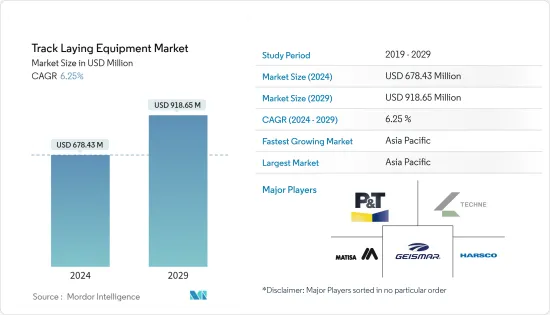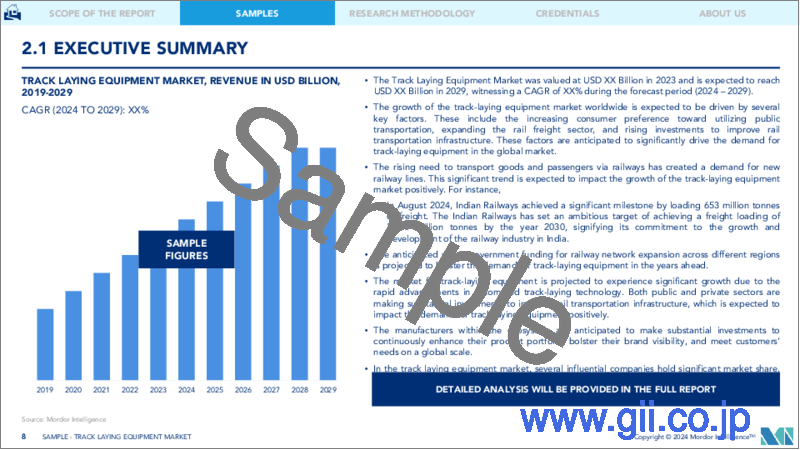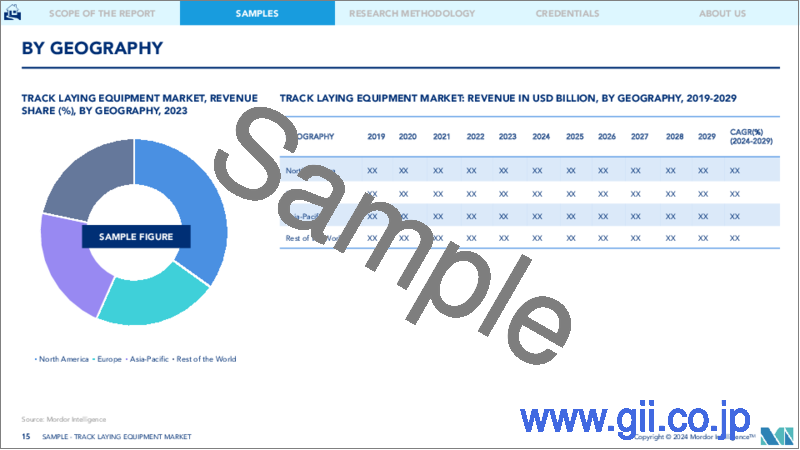|
|
市場調査レポート
商品コード
1521852
軌道敷設機器:市場シェア分析、産業動向と統計、成長予測(2024年~2029年)Track Laying Equipment - Market Share Analysis, Industry Trends & Statistics, Growth Forecasts (2024 - 2029) |
||||||
カスタマイズ可能
適宜更新あり
|
|||||||
| 軌道敷設機器:市場シェア分析、産業動向と統計、成長予測(2024年~2029年) |
|
出版日: 2024年07月15日
発行: Mordor Intelligence
ページ情報: 英文 100 Pages
納期: 2~3営業日
|
- 全表示
- 概要
- 目次
軌道敷設機器の市場規模は、2024年に6億7,843万米ドルと推定され、2029年には9億1,865万米ドルに達すると予測され、予測期間中(2024-2029年)のCAGRは6.25%で成長すると予測されます。

長期的には、公共交通機関の利用を好む消費者の増加、鉄道貨物セクターの拡大、鉄道輸送インフラ改善のための投資の増加が、世界の軌道敷設機器市場の成長の重要な決定要因になると予想されます。レールを利用した貨物輸送需要の増加と鉄道利用者の増加は、新たな鉄道路線の建設要件につながり、軌道敷設機器市場の成長にプラスに寄与します。
主なハイライト
- 中国国家鉄道局によると、中国の鉄道貨物輸送量は2021年の3兆3,200億トンキロに対し、2022年には3兆5,900億トンキロとなり、2021年から2022年にかけて前年比17.7%増となった。
- 経済協力開発機構によると、フランスの旅客鉄道輸送量は2021年の864億1,900万キロメートルに対し、2022年には1,178億5,200万キロメートルに達し、2021年から2022年にかけて前年比36.3%の伸びを記録しました。
鉄道輸送部門の強化に向けた政府の積極的な後押しと、それに続く世界中の既存鉄道路線の改善投資は、現場に配備される先進的な軌道敷設機器の需要をさらに促進すると思われます。欧州のさまざまな新興国は、鉄道線路の敷設や保守を迅速に行うため、軌道敷設機器を導入しています。この機器は、プロジェクト完了までの所要時間を短縮し、建設作業員の重労働を自動化するためにも重要です。
主なハイライト
- 2024年4月、サウジアラビア王国とクウェート政府は、2028年までにリヤドとクウェート市を結ぶ全長60kmの高速鉄道網を建設する計画を発表しました。このような大規模な鉄道プロジェクトをタイムリーに完成させるためには、軌道敷設機器の導入が不可欠となります。
- 2023年3月、米国連邦運輸局(FTA)は、議会への2024年度予算要求で、公共交通建設プロジェクトに割り当てられた44億5,000万米ドルのうち、11の主要鉄道プロジェクトに配分するよう勧告すると発表しました。
今後数年間で、自動軌道敷設装置技術の急速な向上と、鉄道輸送インフラ強化のための官民両部門による投資の増加は、軌道敷設装置市場にプラスの影響を与えると予想されます。さらに、このエコシステムで事業を展開するメーカーは、ブランドの存在感を高め、世界中の顧客に対応するため、多額の投資を行って製品ポートフォリオを絶えずアップグレードしていくと予想されます。
軌道敷設機械市場の動向
新型建設機械セグメントが軌道敷設機械市場を独占している
新型軌道敷設用建設機械は、鉄道軌道の敷設、特に大型鉄道プロジェクトや都市鉄道プロジェクトに広く使用されています。各装置は、プロジェクト要件に応じて最適な吊り上げ能力で製造されます。線路敷設機械の所有には高いコストがかかるため、多くの当局は、これらの機械を現地に配備するか、プロジェクトが完了するまで、指定された期間とあらかじめ決められた料金で機械をレンタルする契約を結んでいます。
そのため、世界各国の政府は、増大する旅客需要に対応するため、鉄道網の充実に過度に注力しています。今後数年間、鉄道利用者の増加が予想されるため、各国政府は複数の路線を結ぶ既存施設を拡張することが重要になり、軌道敷設機器の需要にプラスの影響を与えると思われます。さらに、主に貨物輸送需要の増加に対応するため、複数の鉄道拡張プロジェクトが発表されていることから、国境を越えた活動が重視されるようになっていることも需要を促進しています。
- 国際鉄道連合によると、2022年時点で建設中の高速鉄道路線数が最も多い国は、中国、トルコ、イラクです。2022年時点で建設中の高速鉄道路線は、中国が13,063キロメートル、次いでトルコが1,483キロメートル、イラクが1,200キロメートルとなっています。
- 英国鉄道道路局によると、英国の全国鉄道旅客数は、2021/22年の9億9,010万人に対し、2022/23年には13億4,880万人に達し、2021/22年から2022/23年にかけて前年比36.2%の伸びを示しました。
エコシステム内の様々なメーカーが競争優位を獲得するために戦略を統合しているため、今後数年間は新しい軌道敷設機器の価格が下がると思われます。その多面的な利点から、世界各国の政府は、新しい鉄道プロジェクトをシームレスに完成させるために、この装置を現場に配備することを重視すると思われます。
メンテナンスを目的とした更新用機器の需要も多いが、このセグメントの需要が他のセグメントの需要を上回り、この市場セグメントの成長を後押しすると思われます。さらに、オペレーターが故障を検知し、設備の完全停止前に予防保守を実施できるようにするため、テレマティクスなどの技術が急速に統合されることが予想されます。
アジア太平洋地域が2024年から2029年にかけて最も急成長する市場となる見込み
アジア太平洋地域は、特に中国、インド、マレーシアで新しい鉄道路線を建設するために発表された大規模な投資のおかげで、軌道敷設機器市場で最大のシェアを占めると予想されています。さらに、鉄道を利用した貨物輸送の需要が増加していることや、交通渋滞に対処するために重軌条輸送サービスを利用したいという消費者の嗜好が、アジア太平洋地域における軌道敷設機器の需要を決定する重要な要因となっています。
- インド鉄道省によると、インド鉄道による貨物輸送量は2021年の12億3,094万トンに対し、2022年には14億1,587万トンに達し、2021年から2022年にかけて前年比15.0%の伸びを記録しました。
- 同様に、インド全土の鉄道旅客輸送による収益額は、2022年度の49億8,000万米ドルに対し、2023年度には76億4,000万米ドルに達し、2022年度から2023年度にかけて前年比53.4%の伸びを示しました。
さらに、中国が「一帯一路」構想の下、東南アジア諸国間の輸送連結の強化に積極的に注力していることも、軌道敷設機器の配備需要をさらに押し上げています。マレーシアなどの東南アジア諸国は、鉄道線路用の軌道敷設機器の配備をますます好むようになっています。アジア太平洋はまた、消費者需要の増加に対応するための地下鉄サービスの強化によっても牽引されています。こうした施設では、より迅速なプロジェクト完了と手作業による作業負荷の軽減が重要であるため、近年、アジア太平洋諸国の政府は、プロジェクト現場に先進的な機械を配備することを好んでいます。
- 2023年10月、インドネシア政府はジャカルタとバンドンを結ぶ142キロメートルの高速鉄道を統合しました。プロジェクト費用は73億米ドルを超え、中国が一帯一路構想の一環として資金を提供しました。このプロジェクトは、この2都市間の移動時間を3時間から40分未満に短縮することを目指しています。
大規模な鉄道プロジェクトが進行中であり、政府はアジア太平洋全域の既存の鉄道網の改善にますます力を入れていることから、2024年から2029年にかけて、軌道敷設機器に対する大規模な需要が存在することになります。BEML IndiaやCRRC Corporation Limitedなど、この地域で事業を展開するさまざまなメーカーが、プロジェクトの要件に合わせて製品ポートフォリオを常に多様化していくことが予想されます。
軌道敷設機器産業の概要
軌道敷設機器市場は、エコシステムで事業を展開する様々な国際・国内メーカーにより断片化され、競争が激しいです。主なプレーヤーには、Plasser &Theurer、Techne Kirow GmbH、Martisa Materiel Industriel SA、Geismar、Harsco Corporation、Weihua Group、BEML India、Salcef Group SpAなどがあります。これらの企業は研究開発に多額の投資を積極的に行い、先進的な軌道敷設装置を製造してブランドプレゼンスを高め、市場での競争力を獲得しています。
- 2023年12月、CRSICはマレーシアのクアンタンで、イーストコースト・レールリンク(ECRL)メガレールプロジェクトの建設を支援するため、同社の軌道敷設機械CCPG500Aを配備したと発表しました。同社は、マレーシアでの配備後、同機を使って最初の軌道敷設が行われ、プロジェクト完了まで活用されるとしています。
- 2023年12月、East-West Rail社は、ブレッチリー~ビスター間66kmの新線路敷設プロジェクトの第1段階として、毎日1kmの新線路を敷設するNTC(New Track Construction)列車を投入するコンペを実施すると発表しました。さらに、線路敷設プロジェクトにこの新線路建設列車を投入することで、地元道路から約4,000台のローリーを削減できたと推定されています。
同市場では、線路敷設機器メーカーと政府当局が、新しい線路敷設や線路更新を目的とした適切な機器の配備のために、さまざまなパートナーシップを結ぶことが予想されます。
その他の特典:
- エクセル形式の市場予測(ME)シート
- アナリストによる3ヶ月間のサポート
目次
第1章 イントロダクション
- 調査の前提条件
- 調査範囲
第2章 調査手法
第3章 エグゼクティブサマリー
第4章 市場力学
- 市場促進要因
- 鉄道網拡充のための政府投資の増加が市場成長を促進する見込み
- 市場抑制要因
- 保守・更新コストの高さが市場成長の足かせに
- 業界の魅力- ポーターのファイブフォース分析
- 新規参入業者の脅威
- 買い手/消費者の交渉力
- 供給企業の交渉力
- 代替品の脅威
- 競争企業間の敵対関係の強さ
第5章 市場セグメンテーション
- タイプ別
- 新規建設機械
- リニューアル機器
- 用途別
- ヘビーレール
- 都市鉄道
- 吊り上げ重量別
- 9トンまで
- 9~12トン
- 12トン以上
- 地域別
- 北米
- 米国
- カナダ
- その他北米
- 欧州
- ドイツ
- 英国
- フランス
- イタリア
- その他欧州
- アジア太平洋
- 中国
- インド
- 日本
- 韓国
- その他アジア太平洋地域
- 世界のその他の地域
- 南米
- 中東・アフリカ
- 北米
第6章 競合情勢
- ベンダー市場シェア
- 企業プロファイル
- Plasser & Theurer
- Techne Kirow GmbH
- Weihua Group
- Matisa Matariel Industriel SA
- CRRC Corporation Limited
- Geismar
- Salcef Group SpA
- Harsco Corporation(Enviri)
- BEML India
- Vossloh AG
- Effiage Infra-Rail
- Simplex Engineering and Foundry Works Pvt. Ltd
第7章 市場機会と今後の動向
- 鉄道軌道保守サービスの需要増加が軌道敷設機器の需要を促進する見込み
The Track Laying Equipment Market size is estimated at USD 678.43 million in 2024, and is expected to reach USD 918.65 million by 2029, growing at a CAGR of 6.25% during the forecast period (2024-2029).

In the long term, increasing consumer preference toward availing public transportation medium, expanding the rail freight sector, and the rising investments to improve rail transportation infrastructure are expected to serve as significant determinants for the growth of the track-laying equipment market worldwide. The increasing demand for cargo transportation through rails and the growing number of rail passengers will lead to the requirement to construct new railway lines, positively contributing to the growth of the track-laying equipment market.
Key Highlights
- According to the National Railway Administration of China, the rail freight turnover in China was 3.59 trillion-ton kilometers in 2022 compared to 3.32 trillion-ton kilometers in 2021, representing a 17.7% Y-o-Y growth between 2021 and 2022.
- According to the Organization for Economic Co-Operation and Development, in France, the volume of passenger rail transport reached 117,852 million passenger kilometers in 2022, compared to 86,419 million passenger kilometers in 2021, recording a Y-o-Y growth of 36.3% between 2021 and 2022.
The government's aggressive push toward enhancing the rail transportation sector and the subsequent investment to improve the existing railway lines worldwide will further foster the demand for advanced track-laying equipment to be deployed on sites. Various emerging countries in Europe deploy track-laying equipment to successfully install or maintain railway tracks faster. This equipment is crucial for reducing the turn-around time for project completion and also helps automate heavy-load work for construction workers.
Key Highlights
- In April 2024, the Kingdom of Saudi Arabia and the Kuwaiti Government announced their plan to construct a 60-km high-speed rail network connecting Riyadh and Kuwait City by 2028. The deployment of track-laying equipment for the construction of such a large railway project will become essential for its timely completion.
- In March 2023, the United States Federal Transit Administration (FTA) announced that it is recommending 11 major rail projects receive a share of USD 4.45 billion allocated to public transport construction projects in the fiscal 2024 budget request to Congress.
In the coming years, rapid enhancement in automated track-laying equipment technology and the rising investments by both the public and private sectors to enhance the rail transportation infrastructure are expected to positively impact the market for track-laying equipment. Moreover, manufacturers operating in the ecosystem are expected to invest hefty sums to constantly upgrade their product portfolio to enhance their brand presence and cater to customers worldwide.
Track Laying Equipment Market Trends
The New Construction Equipment Segment is Dominating the Track-Laying Equipment Market
The new track-laying construction equipment is extensively used to install railway tracks, especially for heavy or urban rail projects. Each piece of equipment is manufactured with an optimum lifting capacity, depending on the project requirement. Due to the high cost of owning track-laying equipment, many authorities enter into a contractual agreement to deploy these machines on-site or rent the equipment for a specified period and a pre-determined rate till the completion of the project.
Therefore, governments worldwide are excessively focusing on enhancing their rail network to cater to the increasing passenger demand. With the influx of rail passengers expected in the coming years, it will become crucial for the governments to expand their existing facilities connecting multiple routes, which, in turn, will positively impact the demand for track-laying equipment. Moreover, the rising emphasis on cross-border activity also fuels the demand, owing to the announcement of multiple rail expansion projects, mainly to cater to the increasing demand for cargo transportation.
- According to the International Union of Railways, China, Turkey, and Iraq were the leading countries worldwide with the highest number of high-speed rail lines under construction as of 2022. The high-speed rail lines under construction in China stood at 13,063 kilometers as of 2022, followed by Turkey with 1,483 kilometers of high-speed rail under construction and Iraq with 1,200 kilometers of high-speed rail under construction pipeline.
- According to the United Kingdom Office of Rail and Road, the national rail passenger journeys in the United Kingdom reached 1,348.8 million in 2022/23 compared to 990.1 million in 2021/22, representing a Y-o-Y growth of 36.2% between 2021/22 and 2022/23.
With the integration of various manufacturers in the ecosystem strategizing to gain a competitive advantage, a price reduction for new track-laying equipment will exist in the coming years. Owing to its multifold advantages, governments worldwide will emphasize deploying this equipment on sites to complete new rail projects seamlessly.
Even though there exists a substantial demand for renewal equipment for maintenance purposes, this segment's demand will supersede that of the other, bolstering the growth of this market segment. Moreover, the market will witness rapid integration of technology such as telematics to ensure that operators can detect malfunctions and perform preventive maintenance before the complete shutdown of these equipment.
Asia-Pacific is Expected to be the Fastest Growing Market Between 2024 and 2029
Asia-Pacific is expected to account for the largest share of the track-laying equipment market owing to the massive investments announced to construct new railway lines, especially in China, India, and Malaysia. Furthermore, the increasing demand for cargo transportation via rail and the consumer's preference to avail of heavy rail transportation services to tackle traffic congestion serve as significant determinants of the demand for track-laying equipment across Asia-Pacific.
- According to the Indian Ministry of Railways, the volume of freight carried by Indian railways touched 1,415.87 million metric tons in 2022 compared to 1,230.94 million metric tons in 2021, recording a Y-o-Y growth of 15.0% between 2021 and 2022.
- Similarly, the value of earnings from rail passenger traffic across India touched USD 7.64 billion in FY 2023 compared to USD 4.98 billion in FY 2022, representing a Y-o-Y growth of 53.4% between FY 2022 and FY 2023.
Moreover, China's aggressive focus on enhancing transportation connectivity between Southeast Asian nations under its Belt and Road Initiatives further propels the demand for the deployment of track-laying equipment. Southeast Asian countries such as Malaysia increasingly prefer to deploy track-laying equipment for railway tracks. Asia-Pacific is also driven by the enhancement of metro services to cater to the increasing consumer demand. Faster project completion and reduced manual workload in these facilities become crucial; therefore, in recent years, governments across Asia-Pacific have preferred deploying advanced machinery at project sites.
- In October 2023, the Indonesian government integrated the 142-kilometer high-speed railway connecting Jakarta with Bandung. The project cost exceeded USD 7.3 billion, which China-funded as part of their Belt and Road Initiative. The project aims to reduce the travel time between these two cities from three hours to less than 40 minutes.
With massive railway projects under the pipeline and the government's increasing focus on improving the existing railway network across Asia-Pacific, a massive demand for track-laying equipment will exist between 2024 and 2029. Various manufacturers operating in the region, such as BEML India and CRRC Corporation Limited, are expected to constantly diversify their product portfolio to suit the project requirements.
Track Laying Equipment Industry Overview
The track-laying equipment market is fragmented and highly competitive due to various international and domestic manufacturers operating in the ecosystem. Some major players include Plasser & Theurer, Techne Kirow GmbH, Martisa Materiel Industriel SA, Geismar, Harsco Corporation, Weihua Group, BEML India, and Salcef Group SpA. These players actively invest hefty sums in research and development to manufacture advanced track-laying equipment to enhance their brand presence and gain a competitive edge in the market.
- In December 2023, CRSIC announced the deployment of its CCPG500A track-laying machine in Kuantan, Malaysia, to assist in constructing the East Coast Rail Link (ECRL) mega rail project. The company stated that the first track was laid using the machine after its deployment in Malaysia, and it will be utilized until project completion.
- In December 2023, East-West Rail announced the competition for the first stage of the 66km new track-laying project between Bletchley and Bicester, deploying a New Track Construction (NTC) train to install 1 km of new track daily. Further, it is estimated that deploying this new construction train for the track-laying project saved around 4,000 lorry trips from local roads.
The market is anticipated to witness various partnerships between track-laying equipment and manufacturers and government authorities for deploying suitable equipment to lay new railway tracks or to avail this equipment for track renewal purposes.
Additional Benefits:
- The market estimate (ME) sheet in Excel format
- 3 months of analyst support
TABLE OF CONTENTS
1 INTRODUCTION
- 1.1 Study Assumptions
- 1.2 Scope of the Study
2 RESEARCH METHODOLOGY
3 EXECUTIVE SUMMARY
4 MARKET DYNAMICS
- 4.1 Market Drivers
- 4.1.1 Increasing Government Investments to Expand the Railway Network is Expected to Foster the Growth of the Market
- 4.2 Market Restraints
- 4.2.1 High Cost of Maintenance and Renewal Hampers the Growth of the Market
- 4.3 Industry Attractiveness - Porter's Five Forces Analysis
- 4.3.1 Threat of New Entrants
- 4.3.2 Bargaining Power of Buyers/Consumers
- 4.3.3 Bargaining Power of Suppliers
- 4.3.4 Threat of Substitute Products
- 4.3.5 Intensity of Competitive Rivalry
5 MARKET SEGMENTATION (Market Size in Value - USD)
- 5.1 By Type
- 5.1.1 New Construction Equipment
- 5.1.2 Renewal Equipment
- 5.2 By Application
- 5.2.1 Heavy Rail
- 5.2.2 Urban Rail
- 5.3 By Lifting Capacity
- 5.3.1 Up to 9 Tonnes
- 5.3.2 9-12 Tonnes
- 5.3.3 More than 12 Tonnes
- 5.4 By Geography
- 5.4.1 North America
- 5.4.1.1 United States
- 5.4.1.2 Canada
- 5.4.1.3 Rest of North America
- 5.4.2 Europe
- 5.4.2.1 Germany
- 5.4.2.2 United Kingdom
- 5.4.2.3 France
- 5.4.2.4 Italy
- 5.4.2.5 Rest of Europe
- 5.4.3 Asia-Pacific
- 5.4.3.1 China
- 5.4.3.2 India
- 5.4.3.3 Japan
- 5.4.3.4 South Korea
- 5.4.3.5 Rest of Asia-Pacific
- 5.4.4 Rest of the World
- 5.4.4.1 South America
- 5.4.4.2 Middle East and Africa
- 5.4.1 North America
6 COMPETITIVE LANDSCAPE
- 6.1 Vendor Market Share
- 6.2 Company Profiles*
- 6.2.1 Plasser & Theurer
- 6.2.2 Techne Kirow GmbH
- 6.2.3 Weihua Group
- 6.2.4 Matisa Matariel Industriel SA
- 6.2.5 CRRC Corporation Limited
- 6.2.6 Geismar
- 6.2.7 Salcef Group SpA
- 6.2.8 Harsco Corporation (Enviri)
- 6.2.9 BEML India
- 6.2.10 Vossloh AG
- 6.2.11 Effiage Infra-Rail
- 6.2.12 Simplex Engineering and Foundry Works Pvt. Ltd
7 MARKET OPPORTUNITIES AND FUTURE TRENDS
- 7.1 Increasing Demand for Rail Track Maintenance Services is Expected to Fuel the Demand for Track Laying Equipment






